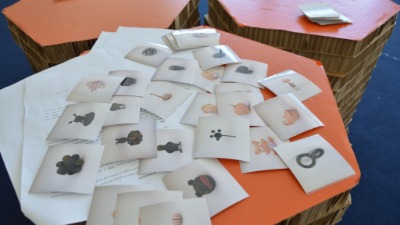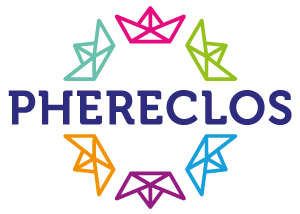Brains at Work (B@W)
- Italy,Trieste - Friuli Venezia Giulia region
- 2017

| Time frame | |
| Categories | |
| Level of Schools | |
| External Partners | |
| Type of Schools | |
| URL | |
| Number of Schools involved | |
| Number of Schoolheads involved | |
| Number of Teachers involved | |
| Number of Students involved | |
| Number of Parents involved | |
| Number of External Partners involved |
Brains@work is a citizen science project resulted from the collaboration between SISSA, Sissa Medialab and a research group in neuroscience, headed by Davide Crepaldi (Language, Learning and Reading Lab). It involves children aged six to eleven in behavioral experiments. The main topics of the experiments are reading, learning, language and olfaction. Children are directly involved in the entire research project, collaborating with scientists and understanding how science works.
BRIEF DESCRIPTION
Brains@work is a citizen science project resulted from the collaboration between SISSA, SISSAMedialab and a research group in neuroscience, headed by Davide Crepaldi (Language, Learning and Reading Lab), which involved children aged 6-11 in one behavioral experiment.
AIMS AND OBJECTIVES
Brains@work project started from the analysis of the needs of different stakeholders involved: one SISSA cognitive neuroscience group and primary school children.
Cognitive neuroscientists often have difficulties in collecting data, because finding participants, getting their authorization (especially in case of children) and organizing the logistics for the data collection are time consuming tasks, needing a lot of human resources as well.
Young students usually have a misrepresented idea of what a scientific experiment really is, where it takes place, and in general what generates the scientific knowledge derived from the experimental approach. Within this framework SISSA Medialab science communication team collaborated in defining a program in which classes from primary schools were invited to visit SISSA and children were directly involved in experimental sessions as participants.
Method
Brains@work is a citizen science project. Citizen Science refers to scientific activities in which non- professional scientists volunteer to participate in data collection, analysis and dissemination.
One major problem was that of informed consent that had to be signed by families before the visit. Organization
SISSA Medialab science communication team took care of the booking procedure, of the relationship with schools and teachers and of the organization of the daily schedules.
Scientists organized intensive data collection sessions providing parallel experimental settings and the presence of scientific assistants.
Program
Visiting classes reached SISSA early in the morning. After an initial presentation of the activities, classes were divided in three groups: while one group was taking part in the experiments (about 6 children in parallel) the other two groups were taken on a tour of the research centre to meet young scientists and take part in interactive activities. The groups switched during the morning in order to let every group take part in the experiment. One collective break was programmed.
People
The project was strongly based on the active participation of PhD students, post-docs and undergraduate trainees of the research group. The interaction between researchers and children brought benefits to both sides, as visitors learned more about real experimental procedures and scientists could collect a huge amount of data in a short time.
The activity is partially funded by an ERC grant of the research group, partially by SISSA and partially by SISSA Medialab.
An initial investment of time was repaid by the optimization of data collection: 450 children took part in the experimental sessions. This large amount of data collected is very impressive and extremely useful for scientists, since the data acquisition process is usually much slower.
Furthermore, it was possible to create a climate of active inclusion in scientific research: the positive impact of the initiative on local schools and families will facilitate the reproduction of the format in the future.
On the other hand, children were really involved in the scientific process, not only for the data collection itself, but also in a form of indirect dissemination. Indeed, the participation of children necessarily involved their families too: both for the information that obviously preceded their formal authorization in taking part in the experimental sessions, and for their emotional involvement in the days before and after the visits.
The project led to the preparation of a manuscript
Pescuma VN, Puccioni O, Parma V, Crepaldi D, Cerrato S, How to Bring Neuroscience to children and Children to Neuroscience, in preparation
The project “Brains@Work” is a unique opportunity for scientists to collect data in a more ecological and efficient way and to promote the science capital of citizens.
Usually data collection in experimental research and science communication are kept separated. As a citizen science project B@W unifies these two fields providing benefits on both sides.
Children took part in real scientific experiments in which they were asked to answer / read / do things.
Researchers planned the set of experiments and provided the lab facilities, and its secretary booked the buses.
SISSA Medialab science communication team took care of the selection of schools and of the contact with teachers. Moreover, it was appointed as the general organiser of the whole project.
SISSA made available its building for the visit, a classroom for some interactive activities and the canteen for the snack time.
Teachers were very happy to take part in this project and sometimes had to adjust their school-time to meet the organization’s needs. The helped with the distribution and recollection of ethical documentation, and facilitated the communication with families.
The presence of participatory activities carried out by SISSA Medialab science communication team allowed the participation in the overall experience of children without consent for the experimental part. This resulted in a highly inclusive experience for all children, although some came from families skeptic towards science. The testing format developed was very flexible – in special cases, it was possible to adapt the tasks to the needs of children – and the presence of tasks with verbal and with non-verbal demands enabled researchers to include atypical populations, too. Specifically, participants with learning disabilities and those with ASD were directed to the olfaction path*. The former group would have been potentially stressed at facing a reading experience but had no issues pointing to facial expressions on a screen; the latter group met the research inclusion criteria of the olfaction group, while promoting inclusion of neuro-diverse individuals as research participants. The data that failed to pass the inclusion criteria were excluded post-hoc, allowing all children to access a complete scientific experience, irrespective of data usability on the researchers’ side.
*During the first edition of B@W also olfactory tests were run, while in the second edition there was not the olfactory part.
As with all the experimental procedure that involve participants, the approval of the Ethical Review Board was essential. The project was approved and a set of documents was prepared aimed at informing the parents as thoroughly as possible about the experimental procedures via their school teachers; and at gathering all the necessary information for the scientific experiments (e.g., children with a reading acquisition impairment, such as dyslexia, may display).
Specifically, the documents were:
i) a short letter addressed to school teachers/principals describing the proposal of a hands-on science experience;
ii) a similar short letter addressed to all parents;
iii) a detailed description of the experimental session, addressed to the parents interested in letting their children participate in the research experience;
iv) an informed consent form in two copies (one for the parents, one for the researchers to keep);
v) a form with an anonymous identifier in which parents could provide information regarding developmental or neurological impairment, and sensory abilities of their children;
vi) a photographic consent and release form (optional).
The partners involved (neuroscience lab, SISSAMedialab, SISSA and schools) have worked together since the beginning in order to develop a programme that could fulfill the needs of all the stakeholders. Every partner took advantage of its expertise and facilities to build the best results.
The ownership of the project is shared between SISSA Medialab and the the Language, Learning and Reading Lab. Indeed, these two partners worked together for writing a manuscript eligible for the publication and co-signed it.
Research staff (PhD students, post-doc, trainees) has been trained a little in how to deal with school groups by science communicators and the science communication team continuously supported them.
Some of them took part in the Science Dialogues Training course in Communication of science promoted by SISSA Medialab for the SISSA outreaching group.
The relationship between partners (SISSA, SISSA Medialab, schools) was very fruitful, resulting in a great project.
Specifically, the relationship and the cooperation between SISSA Medialab science communication team and the Language, Learning and Reading Lab was very tight and nice.
There are no external partners beyond SISSAMedialab srl (coordinator), a research group of SISSA (University/Research center) and schools.
The visit of the research institute, the emotional engagement and the participation in the activities should lead to an increasing interest in children in scientific subjects and in reaching high level of education since the people involved (researchers, PhD students, post-docs, other graduated staff) also act as role models. However, since the participants are very young, they are far from the moment in which they could make a selection among school subjects (in Italy the first broad selection of subjects is made at the age of 14, choosing the type of high school).
